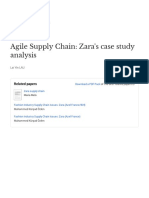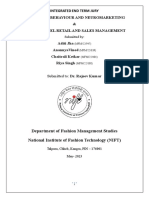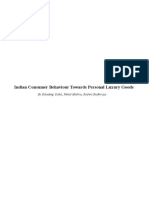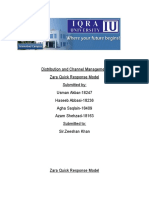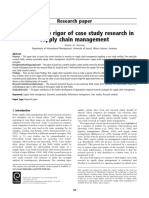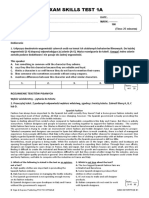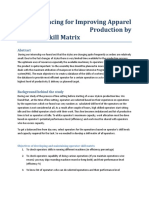RMT Assignment: N I F T, H - K
RMT Assignment: N I F T, H - K
Uploaded by
Varun MehrotraCopyright:
Available Formats
RMT Assignment: N I F T, H - K
RMT Assignment: N I F T, H - K
Uploaded by
Varun MehrotraOriginal Description:
Original Title
Copyright
Available Formats
Share this document
Did you find this document useful?
Is this content inappropriate?
Copyright:
Available Formats
RMT Assignment: N I F T, H - K
RMT Assignment: N I F T, H - K
Uploaded by
Varun MehrotraCopyright:
Available Formats
NATIONAL INSTITUTE OF FASHION TECHNOLOGY, HAUZ-KHAS
RMT ASSIGNMENT
SUBMITTED BY-
SALONI MISHRA ARUNAV SUMIT KUMAR M.FTECH SEM-2
ABOUT ZARA Zara is part of the Inditex Group of Spanish fashion retailers. Inditex, one of the worlds largest fashion distributors, it has more than 4,780 stores in 77 countries in Europe, the Americas, Asia and Africa. ZARA is the flagship chain store of Inditex Group owned by Spanish tycoon Amancio Ortega. Head Quarters in Coruna, Spain, where the first ZARA store opened in 1975.In the 1980s Zara pioneered the concept of what is now considered "fast fashion. Their product portfolio is comprises with men, women and kids(ZARA KIDS)clothes, shoes, cosmetics and accessories.
CASE STUDY RELATED TO ITS SUPPLY CHAIN
STATISTICS
15 days from designs to products VS. industry average of 6-9 months 12 inventory turnovers/year VS. industry average 3-4 times 12,000 designs/year 30,000 Stock-Keeping Units (SKUs)/year Unsold items account for 10% of stock VS. industry average 17%~20% Commits 50%~60% of production in advance of the season VS. 80%~90% for other. Supply Chain Suppliers are all close to their factories so ZARA can order on a need basis. ZARA buys fabric in only 4 different colors; designs and cuts its fabric in-house Clothes are ironed in advance and packed on hangers, with security and price tags affixed Overnight trucks are used to deliver to European stores and airfreight is used to ship to other countries. ZARA changes their designs 2 weeks per time. Products of ZARA is very popular with young females (age of 24 -25)
Vertically integrated supply chain where design, production, distribution, and retailing were integrated. The vertical integration of ZARAs production system allows them to place a garment in any store around the world in a period between two to three weeks. Vertically Integrated Supply Chain
FACTOR IN THE PROFITABILITY FORMULABuy low, sell high; Buy on credit, sell on cash. Zara, which contributes around 65 per cent of group sales , concentrates on three winning formulae to bake its fresh fashion:
Short Lead Time = More fashionable Lower quantities = Scarce supply More styles = More choice, and more chances of hitting.
In Spain, 200 fashion designers are in charge of new designs for the clothing line. They select the most cost effective fabric for the new designs. Designs will be made into models when sent to the factory. The computer then decide how to shear fabrics in order to waste as little as possible. Fabric will be sent to the factories.
After the sewing process, products will be sent back to the factory for button nailing, ironing and inspection. Up to tens of kilometers of underground
transmission channel connects all the processors. Label trademarks for different countries.
Why using Vertical integration?
Local sourcing of raw material Cutting cost because they do not outsource any channel Fast time-to-customer Cutting time, faster, effective, and efficient Mass customization Low process costs
INVENTORYStores place orders twice per week and the supply of finished goods is matched to store demand.
Production is then increased or decreased in the flexible production facilities. Demand based production means there is very little inventory in Zaras supply chain, which results in much lower working capital requirements.
PROCUREMENT /INBOUND LOGISTICS
ZARA buys its raw materials from Italy, Spain, and Greece. Reason is final product can be push to the final selling point quickly. suppliers have agreed to supply material within 5 days to ZARAs facility in spain. due to this most of the inbound logistics are road haulage.(mainly trucks).
PRICING
As production is carried out in Spain where average wages are higher than low cost Asian countries so factory wage costs will be higher than competitors, which will affect margins.
DELIVERY
Deliveries typically arrive one to two days after ordering with most deliveries arriving by truck from the Spanish factories. Clothes are then put straight onto the sales floor and are available to purchase.
STRENGTHS
It produces about 11,000 distinct items annually compared with 2,000 to 4,000 items for its key competitors. The company can design a new product and have finished goods in its stores in four to five weeks; it can modify existing items in as little as two weeks. Shortening the product life cycle means greater success in meeting consumer preferences.
An average high-street store in Spain expects customers to visit three times a year. That goes up to 17times for Zara. 50% of the products Zara sells are manufactured in Spain, 26% in the rest of Europe, and 24% in Asian and African countries and the rest of the world.
INFORMATION TECHNOLOGY (IT)
A. Approaches and Organization Zara's approach to the organizations utilization of IT was aligned with its preferences for speed and decentralized decision making. There is no chief information officer appointed and no formal processes for setting an IT budget on specific technology investments and projects. Essential applications were developed in-house as most commercial packages were not suitable for Zaras unique operations. B. La Coruna In La Coruna, applications developed internally were used to prepare and distribute the offer globally via the internet, receive orders from all of its stores and aggregate them. When the supply and demand were imbalanced, it will be highlighted and Commercials decisions on product allocation when demand exceeded supply will be executed. Theoretical inventory of each SKU at each store were managed with a separate application. Though it was not entirely accurate, it was not a great concern since it was only used to facilitate stock allocation decisions.
CONCLUSION
Zaras updates after the case study and identify several important updates to its SC which includes a more accurate way of managing its inventories, an addition to its sales channel and improvements to retailers work process. However, it is noted that Zara still experiences several SC challenges. These include key issues such as the limitation of its companywide interconnectivity, obsolescence and restriction of the technologies currently used and lastly, the need to maintain its leadership in the industry with online expansion.
Based on the challenges discussed above, we have came up with three different recommendations to tackle the issues at hand. They are establishing mobile enterprise applications, upgrading of POS terminals and further improvements on its e-commerce. However, each of these recommendations has its benefits, disadvantages and associated risks. Zara will need to carefully evaluate these recommendations and mitigate possible risks before implementing them. All in all, we believe that through the implementation of more advanced technologies, whilst having proper management of possible risks, Zara will be able to further enhance their operations and remain as a dominant player in the fast fashion industry.
You might also like
- Yamata Fy 8500Document29 pagesYamata Fy 8500yu7bx100% (2)
- Kids Clothing Safety Manual 2022Document85 pagesKids Clothing Safety Manual 2022mdfazle165No ratings yet
- Summer Training Report On A Study On Marketing and Sales StrategyDocument45 pagesSummer Training Report On A Study On Marketing and Sales StrategyAryan Sahu100% (3)
- Zara Vs GapDocument16 pagesZara Vs GapSilvia Tjang100% (1)
- Laundry Service ProposalDocument4 pagesLaundry Service Proposal'Florian Calzado'100% (1)
- GPS-To-GO Case Facts, Analysis & Suggestions: Arun Vishnu Poornima M.R Rohith RDocument10 pagesGPS-To-GO Case Facts, Analysis & Suggestions: Arun Vishnu Poornima M.R Rohith RArunNo ratings yet
- Zara Business Strategy - Zara Critically Evaluate, 2010 To 2014 - 2:1 Grade Derby UniDocument17 pagesZara Business Strategy - Zara Critically Evaluate, 2010 To 2014 - 2:1 Grade Derby Uni100134260100% (4)
- Outsourcing Project On H&MDocument12 pagesOutsourcing Project On H&Mxrodius08100% (1)
- Zara Operation ManagementDocument9 pagesZara Operation Managementmuhammadali_02233% (3)
- Employee Handbook Fairmont Scottsdale Princess Grooming Guidelines 2015Document5 pagesEmployee Handbook Fairmont Scottsdale Princess Grooming Guidelines 2015max997No ratings yet
- Graduation Project 'Document43 pagesGraduation Project 'Sushant100% (1)
- Vertical Integration & Zara Retailing: Presented By-Amkoa, Sally Lin, Xinqi Senecha, Niharika Towers, KathleenDocument17 pagesVertical Integration & Zara Retailing: Presented By-Amkoa, Sally Lin, Xinqi Senecha, Niharika Towers, KathleenShashwat ShuklaNo ratings yet
- IEOR 162 Group Project (Fall 2013)Document4 pagesIEOR 162 Group Project (Fall 2013)DracoAndruw0% (2)
- Zara Operation ManagementDocument11 pagesZara Operation ManagementDuaa FatimaNo ratings yet
- Bis CorporationDocument2 pagesBis CorporationXinru ChenNo ratings yet
- Itsdi: IT For Fashion - ZARA CaseDocument21 pagesItsdi: IT For Fashion - ZARA CaseSawan AcharyNo ratings yet
- Zara Case Study - Amazing)Document46 pagesZara Case Study - Amazing)Sudha Bharatan100% (2)
- HM CompanyDocument42 pagesHM CompanyThu Phương NguyễnNo ratings yet
- On Craft ClusterDocument50 pagesOn Craft ClusterTapas MondalNo ratings yet
- Industrial Sewing Machine Needles Replacement Policy - Auto GarmentDocument4 pagesIndustrial Sewing Machine Needles Replacement Policy - Auto GarmentVarun MehrotraNo ratings yet
- List of Hospitals/Diagnostic Centres Empanelled Under Cghs Delhi &Document29 pagesList of Hospitals/Diagnostic Centres Empanelled Under Cghs Delhi &Varun MehrotraNo ratings yet
- Eton SystemDocument17 pagesEton SystemVarun MehrotraNo ratings yet
- Istyle - Marketing PlanDocument17 pagesIstyle - Marketing PlanRhea Thomas100% (1)
- Supply Chain Management ZaraDocument9 pagesSupply Chain Management ZaraMeghna Singh ChouhanNo ratings yet
- Zara Spanish Apparel BrandDocument8 pagesZara Spanish Apparel BrandNelum Shehzade100% (3)
- Zara Case: Supply Chain 2015Document16 pagesZara Case: Supply Chain 2015CésarChávezNo ratings yet
- Zara Supply ChainDocument7 pagesZara Supply ChainaktaruzzaansyedNo ratings yet
- Complete Report ZaraDocument17 pagesComplete Report ZaraXain AbidinNo ratings yet
- Zara The Speeding BulletDocument3 pagesZara The Speeding BulletSomnath Manna100% (1)
- Zara PrachiDocument16 pagesZara PrachiPrachi_Garg_8226No ratings yet
- FinalDocument8 pagesFinalPham Van Phung - K15 FUG CTNo ratings yet
- ZARA's Agile Supply ChainDocument13 pagesZARA's Agile Supply Chainmizbuziey100% (2)
- HBR + Zara CaseDocument34 pagesHBR + Zara CaseZahra Maryam AshriNo ratings yet
- Zara A Global ForceDocument9 pagesZara A Global Forceromeo_venus1No ratings yet
- Vertical Integration Against Vs Outsourcing in Fasion IndustryDocument2 pagesVertical Integration Against Vs Outsourcing in Fasion Industrywaleed AfzaalNo ratings yet
- Agile Supply Chain: Zara's Case Study Analysis: Related PapersDocument12 pagesAgile Supply Chain: Zara's Case Study Analysis: Related PapersLong Live Pakistan100% (1)
- CBNM JuryDocument15 pagesCBNM JuryCHAITRALI DHANANJAY KETKARNo ratings yet
- Zara FinalDocument32 pagesZara FinalSano sandeep100% (1)
- A Case Study of ZaraDocument2 pagesA Case Study of ZaraSurbhî GuptaNo ratings yet
- A8 - Interim ReportDocument14 pagesA8 - Interim ReportRashi ShahNo ratings yet
- Muhammad Kaleem Ullah 03-398192-032 MSPM-BDocument35 pagesMuhammad Kaleem Ullah 03-398192-032 MSPM-BMuazam AliNo ratings yet
- Zara SCMDocument8 pagesZara SCMAnurag MosanNo ratings yet
- Zara Project FileDocument47 pagesZara Project FileNIshkarsh BayambuNo ratings yet
- Case Study Zara Fast FashionDocument9 pagesCase Study Zara Fast FashionBhoomika Bansal100% (1)
- MFM Jury Assignment PDFDocument29 pagesMFM Jury Assignment PDFSatadeep DattaNo ratings yet
- August 20, 2010: Supply Chain Management of ZaraDocument11 pagesAugust 20, 2010: Supply Chain Management of ZaraHosna Mobarak Farhan100% (1)
- Zara CaseDocument13 pagesZara Casekanumishra100% (2)
- Zara Quick Response ModelDocument7 pagesZara Quick Response ModelHaseeb AbbasiNo ratings yet
- Environmental Scanning - ZARADocument9 pagesEnvironmental Scanning - ZARAEmezi ObisikeNo ratings yet
- Zara Case StudyDocument4 pagesZara Case StudyVidarbha ChouhaanNo ratings yet
- Work Measurement Techniques Methods TypesDocument5 pagesWork Measurement Techniques Methods TypesManoj BallaNo ratings yet
- Fast and Ultra-Fast Fashion Supply Chain Management - An Exploratory ResearchDocument17 pagesFast and Ultra-Fast Fashion Supply Chain Management - An Exploratory ResearchSomesh AgrawalNo ratings yet
- Assessing The Rigor of Case Study Research in Supply Chain ManagementDocument10 pagesAssessing The Rigor of Case Study Research in Supply Chain ManagementllanojairoNo ratings yet
- Understanding Zara's Supply ChainDocument7 pagesUnderstanding Zara's Supply ChainDYPUSM WECNo ratings yet
- H&MDocument12 pagesH&MAshish SachdevaNo ratings yet
- ZARA SPO Case Study - Betty, Tamara, Lena and LoraDocument43 pagesZARA SPO Case Study - Betty, Tamara, Lena and LoraLolsi Santurdzhiyan67% (3)
- Tata Motors 1Document24 pagesTata Motors 1Prachir GuptaNo ratings yet
- RQ1E40A035 - Online Assignment 3 - MKT518 - 11911770 MKT 518 CA 3Document21 pagesRQ1E40A035 - Online Assignment 3 - MKT518 - 11911770 MKT 518 CA 3mayankNo ratings yet
- H&M in EnglezaDocument17 pagesH&M in EnglezaAna PaladiNo ratings yet
- B8 - GPS To GoDocument7 pagesB8 - GPS To GoBiranchi Prasad Sahoo0% (1)
- Zara Supply Chain - Pros and ConsDocument5 pagesZara Supply Chain - Pros and ConsjunaidNo ratings yet
- Air Asia Marcom - PPT 2Document81 pagesAir Asia Marcom - PPT 2Mas Love MakNo ratings yet
- H&M Ops StrategyDocument13 pagesH&M Ops StrategyDanzo ShahNo ratings yet
- Quality Control ProjectDocument18 pagesQuality Control Projectdana mubarakNo ratings yet
- Zara Company ReportDocument7 pagesZara Company ReportKimbraPataraNo ratings yet
- Zara SCM StrategiesDocument7 pagesZara SCM StrategiesChandan BaithaNo ratings yet
- Zara Supply ChainDocument30 pagesZara Supply ChainUpasna HandaNo ratings yet
- Zara Caso1Document11 pagesZara Caso1BillyBonillaPauloNo ratings yet
- Value Creation in Global Apparel Industry: Assignment 1Document11 pagesValue Creation in Global Apparel Industry: Assignment 1Shivi Shrivastava100% (1)
- All Shahi Employees: Anonymous Survey Online Easy To Fill OutDocument1 pageAll Shahi Employees: Anonymous Survey Online Easy To Fill OutVarun MehrotraNo ratings yet
- Boutique Manager - QPDocument29 pagesBoutique Manager - QPVarun MehrotraNo ratings yet
- Threads: Training & Development/Od Shahi Exports PVT LTDDocument30 pagesThreads: Training & Development/Od Shahi Exports PVT LTDVarun MehrotraNo ratings yet
- Busana Apparel Group - Tommy FH'17Document80 pagesBusana Apparel Group - Tommy FH'17Varun MehrotraNo ratings yet
- Machine Health Evaluation SheetDocument4 pagesMachine Health Evaluation SheetVarun MehrotraNo ratings yet
- Date 22dec PDFDocument1 pageDate 22dec PDFVarun MehrotraNo ratings yet
- SMEDA-Industry Support Program: Application of Lean ProductionDocument33 pagesSMEDA-Industry Support Program: Application of Lean ProductionVarun MehrotraNo ratings yet
- Scale Settings: Red 45 Amber 25 Green 30 Gap 100Document3 pagesScale Settings: Red 45 Amber 25 Green 30 Gap 100Varun MehrotraNo ratings yet
- Date 21dec PDFDocument1 pageDate 21dec PDFVarun MehrotraNo ratings yet
- Date 21dec PDFDocument1 pageDate 21dec PDFVarun MehrotraNo ratings yet
- Total: Line 1 ITEM No.:-M675Document83 pagesTotal: Line 1 ITEM No.:-M675Varun MehrotraNo ratings yet
- EMR FormatDocument10 pagesEMR FormatVarun MehrotraNo ratings yet
- Offer Letter - Shahi Exports Pvt. Ltd.Document1 pageOffer Letter - Shahi Exports Pvt. Ltd.Varun Mehrotra100% (1)
- Feasibility of Using 3D Printed Sewing Machine Parts in Garment ManufacturingDocument7 pagesFeasibility of Using 3D Printed Sewing Machine Parts in Garment ManufacturingVarun MehrotraNo ratings yet
- Abs Suppliers in India: Spectrum 3D CreationsDocument2 pagesAbs Suppliers in India: Spectrum 3D CreationsVarun MehrotraNo ratings yet
- AbstarctDocument2 pagesAbstarctVarun MehrotraNo ratings yet
- Faculty Mentor: Dr. PRABIR Jana Mr. Deepak Panghal Industry Mentor: Mr. UDAY N B (Sales & Technical Manager)Document2 pagesFaculty Mentor: Dr. PRABIR Jana Mr. Deepak Panghal Industry Mentor: Mr. UDAY N B (Sales & Technical Manager)Varun MehrotraNo ratings yet
- Prototype: X A B YDocument7 pagesPrototype: X A B YVarun MehrotraNo ratings yet
- Managing Brand EquityDocument2 pagesManaging Brand EquityVarun MehrotraNo ratings yet
- ProductivityDocument13 pagesProductivityVarun MehrotraNo ratings yet
- Arun Kumar Varun MehrotraDocument12 pagesArun Kumar Varun MehrotraVarun MehrotraNo ratings yet
- Organizational Behavior: Introduction ToDocument24 pagesOrganizational Behavior: Introduction ToVarun MehrotraNo ratings yet
- Fact About Yarn FaultsDocument12 pagesFact About Yarn FaultsSabeeh Ul HassanNo ratings yet
- 14 Z7346 Simplicity JournalDocument0 pages14 Z7346 Simplicity JournalTaller Artes CreativasNo ratings yet
- IMPA 150141 - SHEET, ALL COTTON, BLUE, 1370 X 2300 MMDocument2 pagesIMPA 150141 - SHEET, ALL COTTON, BLUE, 1370 X 2300 MMMARZENAN ENIGMA MOKHTARNo ratings yet
- Panodia Albums Colletion 2009Document6 pagesPanodia Albums Colletion 2009Rolando DaclanNo ratings yet
- Training Plan Qualification: Dressmaking NC II: Template 2 Supervise Work-Based Learning Document No. Issued By: SfistDocument1 pageTraining Plan Qualification: Dressmaking NC II: Template 2 Supervise Work-Based Learning Document No. Issued By: SfistArts of Ma Ley0% (1)
- Baby Cot Blanket Crochet Pattern FreeDocument26 pagesBaby Cot Blanket Crochet Pattern FreeFitriyanti Nuur KhasanahNo ratings yet
- TextDocument2 pagesTextRatul HasanNo ratings yet
- List of Projects by Banu Mukhtar SteelDocument5 pagesList of Projects by Banu Mukhtar SteelZiaullahNo ratings yet
- Exam Skills Test 1A: Rozumienie Ze SłuchuDocument2 pagesExam Skills Test 1A: Rozumienie Ze SłuchuMarlena PietrasNo ratings yet
- FIFTIES (50s) Did You Know Barbie Was Created in 1950: %C) - C CCC .c$2 5 c6Document16 pagesFIFTIES (50s) Did You Know Barbie Was Created in 1950: %C) - C CCC .c$2 5 c6Pablo Becerra LellenquienNo ratings yet
- Arq OrellanaDocument31 pagesArq OrellanaMabu Chvetz KyUpNo ratings yet
- Selection Guide Specialty Carbon Blacks For PlasticsDocument8 pagesSelection Guide Specialty Carbon Blacks For Plasticsrahul_2005No ratings yet
- EPCGDocument18 pagesEPCGAaditya MathurNo ratings yet
- Notes Class 8 Geography Chapter 4Document52 pagesNotes Class 8 Geography Chapter 4Varsha SuranaNo ratings yet
- Reliance Enters Into A Joint Venture For Textile BusinessDocument2 pagesReliance Enters Into A Joint Venture For Textile BusinessFlame Of Truth 2014No ratings yet
- Ghanshyam Das Birla ProfileDocument3 pagesGhanshyam Das Birla Profileabhinavlakh0% (1)
- Standard Operatring Procedure in Cutting RoomDocument6 pagesStandard Operatring Procedure in Cutting RoomarivaazhiNo ratings yet
- The Effect of Lean On Occupational Health and Safety and Productivity in The Garment Industry - A Literature ReviewDocument21 pagesThe Effect of Lean On Occupational Health and Safety and Productivity in The Garment Industry - A Literature ReviewImi MaximNo ratings yet
- INTERNSHIP REPORT-Arvind Ltd-Arushi Srivastava-Vaishali Rai NIFT Delhi PDFDocument110 pagesINTERNSHIP REPORT-Arvind Ltd-Arushi Srivastava-Vaishali Rai NIFT Delhi PDFRonak Joshi0% (1)
- Alquat CLA. Denim Bleach Booster.Document10 pagesAlquat CLA. Denim Bleach Booster.L.N.CHEMICAL INDUSTRYNo ratings yet
- Simens Washer and Drier ManualDocument63 pagesSimens Washer and Drier Manualtadesse_woudnehNo ratings yet
- Line Balancing For Improving Apparel Production by Operator Skill MatrixDocument10 pagesLine Balancing For Improving Apparel Production by Operator Skill MatrixVishal ChoudharyNo ratings yet
- Types of Washing in Denims: Prepared by - Sunny MalhotraDocument13 pagesTypes of Washing in Denims: Prepared by - Sunny MalhotraTalib aleemNo ratings yet
- 2010 2011 Lamellar Catalogue SmallDocument13 pages2010 2011 Lamellar Catalogue Smalljamogatta100% (1)
- Luxe Lifestyles NYC "Lavish Living" Celebrates Their One Year AnniversaryDocument2 pagesLuxe Lifestyles NYC "Lavish Living" Celebrates Their One Year AnniversaryPR.comNo ratings yet



































